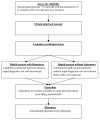Comparative field performance and adherence to test results of four malaria rapid diagnostic tests among febrile patients more than five years of age in Blantyre, Malawi
- PMID: 20646312
- PMCID: PMC2916916
- DOI: 10.1186/1475-2875-9-209
Comparative field performance and adherence to test results of four malaria rapid diagnostic tests among febrile patients more than five years of age in Blantyre, Malawi
Abstract
Background: Malaria rapid diagnostics tests (RDTs) can increase availability of laboratory-based diagnosis and improve the overall management of febrile patients in malaria endemic areas. In preparation to scale-up RDTs in health facilities in Malawi, an evaluation of four RDTs to help guide national-level decision-making was conducted.
Methods: A cross sectional study of four histidine rich-protein-type-2- (HRP2) based RDTs at four health centres in Blantyre, Malawi, was undertaken to evaluate the sensitivity and specificity of RDTs, assess prescriber adherence to RDT test results and explore operational issues regarding RDT implementation. Three RDTs were evaluated in only one health centre each and one RDT was evaluated in two health centres. Light microscopy in a reference laboratory was used as the gold standard.
Results: A total of 2,576 patients were included in the analysis. All of the RDTs tested had relatively high sensitivity for detecting any parasitaemia [Bioline SD (97%), First response malaria (92%), Paracheck (91%), ICT diagnostics (90%)], but low specificity [Bioline SD (39%), First response malaria (42%), Paracheck (68%), ICT diagnostics (54%)]. Specificity was significantly lower in patients who self-treated with an anti-malarial in the previous two weeks (odds ratio (OR) 0.5; p-value < 0.001), patients 5-15 years old versus patients > 15 years old (OR 0.4, p-value < 0.001) and when the RDT was performed by a community health worker versus a laboratory technician (OR 0.4; p-value < 0.001). Health workers correctly prescribed anti-malarials for patients with positive RDT results, but ignored negative RDT results with 58% of patients with a negative RDT result treated with an anti-malarial.
Conclusions: The results of this evaluation, combined with other published data and global recommendations, have been used to select RDTs for national scale-up. In addition, the study identified some key issues that need to be further delineated: the low field specificity of RDTs, variable RDT performance by different cadres of health workers and the need for a robust quality assurance system. Close monitoring of RDT scale-up will be needed to ensure that RDTs truly improve malaria case management.
Figures
References
-
- Facts on ACTs (Artemisinin-based Combination Therapies) 2006. http://www.rollbackmalaria.org/cmc_upload/0/000/015/364/RBMInfosheet_9.htm Update.
-
- Rakotonirina H, Barnadas C, Raherijafy R, Andrianantenaina H, Ratsimbasoa A, Randrianasolo L, Jahevitra M, Andriantsoanirina V, Menard D. Accuracy and reliability of malaria diagnostic techniques for guiding febrile outpatient treatment in malaria-endemic countries. Am J Trop Med Hyg. 2008;78:217–221. - PubMed
-
- World Health Organization. The role of laboratory diagnosis to support malaria disease management. Focus on the use of rapid diagnostic tests in areas of high transmission, Report of a WHO Technical Consultation, 25-26 October 2004. Geneva; 2006.
-
- World Health Organization. Guidelines for the treatment of malaria. 2. Geneva; 2010. - PubMed
Publication types
MeSH terms
Substances
LinkOut - more resources
Full Text Sources
Medical


